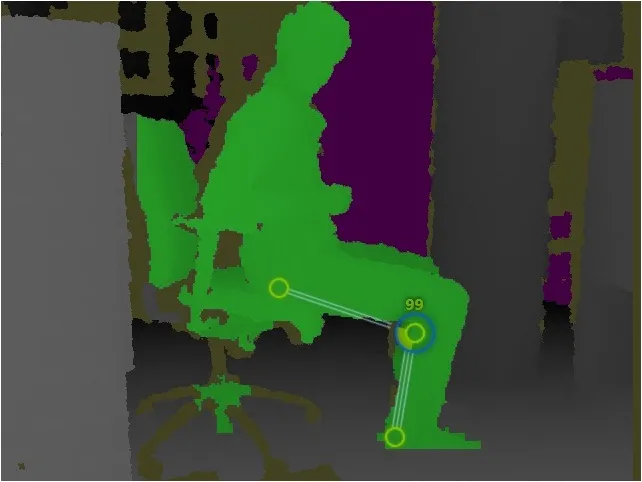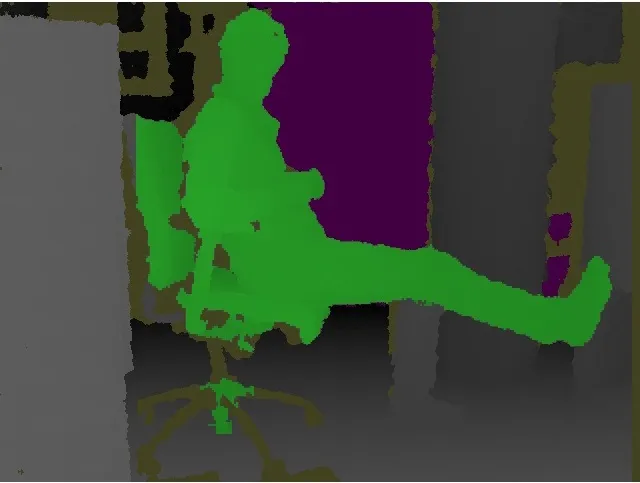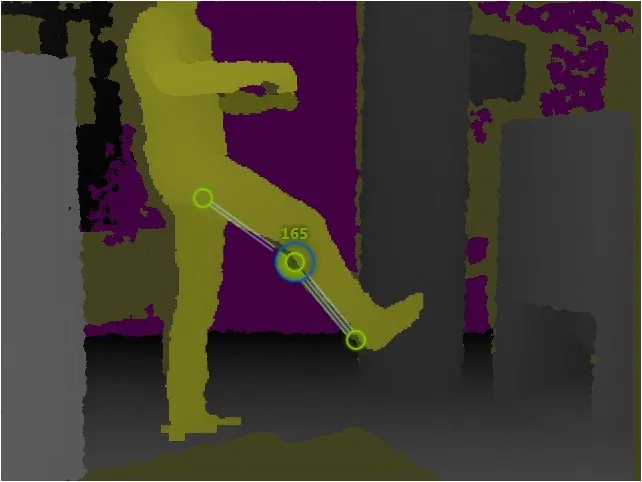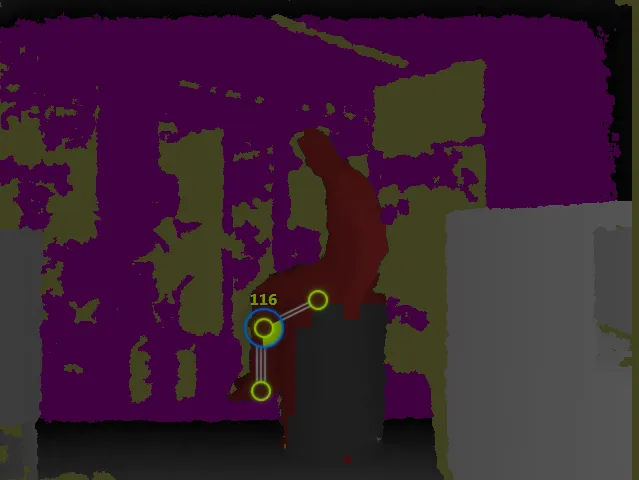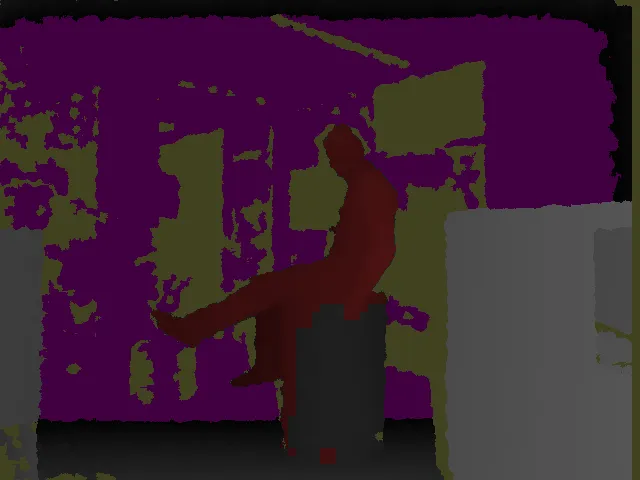如Renaud Dumont所说,我需要对JointTrackingState进行处理。由于您使用的是膝盖,我使用变量leftknee和rightknee来进行操作,它们都是Joints。这是代码,您可以使用JointType.FootRight和JointType.FootLeft以及Hip类型进行操作,但我将其留给您自己决定。
static Skeleton first = new Skeleton();
Joint leftknee = first.Joints[JointType.KneeLeft];
Joint rightknee = first.Joints[JointType.KneeRight];
if ((leftknee.TrackingState == JointTrackingState.Inferred ||
leftknee.TrackingState == JointTrackingState.Tracked) &&
(rightknee.TrackingState == JointTrackingState.Tracked ||
rightknee.TrackingState == JointTrackingState.Inferred))
{
}
或者,如果您只想追踪一只膝盖,或者两只膝盖,您可以这样做:
if ((leftknee.TrackingState == JointTrackingState.Inferred ||
leftknee.TrackingState == JointTrackingState.Tracked) &&
(rightknee.TrackingState == JointTrackingState.Tracked ||
rightknee.TrackingState == JointTrackingState.Inferred))
{
}
else if (leftknee.TrackingState == JointTrackingState.Inferred ||
leftknee.TrackingState == JointTrackingState.Tracked)
{
}
else if (rightknee.TrackingState == JointTrackingState.Inferred ||
rightknee.TrackingState == JointTrackingState.Tracked)
{
}
提醒一下,Skeleton被设置为static是因为它可以用于制作关节。
static Skeleton first
与......相反
Skeleton first;
编辑1
我得出结论这是非常难做的,我认为上述方法会起作用,但我只是想把我正在努力工作的内容包含在内,以防您能找到一些使其起作用的方法。无论如何,这是我正在努力的代码,它是另一个
class,也是另一个
SkeletalTrackingState,我试图在其中制作一个
Inferred enum。但不幸的是,
enum是
不可能继承的。如果你发现有类似作用的东西可以运行,我将永远尊重您作为比我优秀的程序员;)话不多说,这就是我试图制作的
.dll:
using System;
using System.Collections.Generic;
using System.Linq;
using System.Text;
using Microsoft.Kinect;
namespace IsInferred
{
public abstract class SkeletonInferred : Skeleton
{
public bool inferred;
static Skeleton first1 = new Skeleton();
Joint handright;
Joint handleft;
Joint footright;
Joint footleft;
Joint ankleleft;
Joint ankleright;
Joint elbowleft;
Joint elbowright;
Joint head;
Joint hipcenter;
Joint hipleft;
Joint hipright;
Joint shouldercenter;
Joint shoulderleft;
Joint shoulderright;
Joint kneeleft;
Joint kneeright;
Joint spine;
Joint wristleft;
Joint wristright;
public SkeletonInferred(bool inferred)
{
}
public enum Inferred
{
NotTracked = SkeletonTrackingState.NotTracked,
PositionOnly = SkeletonTrackingState.PositionOnly,
Tracked = SkeletonTrackingState.Tracked,
Inferred = 3,
}
private void IsInferred(object sender, AllFramesReadyEventArgs e)
{
handright = first1.Joints[JointType.HandRight];
handleft = first1.Joints[JointType.HandLeft];
footright = first1.Joints[JointType.FootRight];
footleft = first1.Joints[JointType.FootLeft];
ankleleft = first1.Joints[JointType.AnkleLeft];
ankleright = first1.Joints[JointType.AnkleRight];
elbowleft = first1.Joints[JointType.ElbowLeft];
elbowright = first1.Joints[JointType.ElbowRight];
head = first1.Joints[JointType.Head];
hipcenter = first1.Joints[JointType.HipCenter];
hipleft = first1.Joints[JointType.HipLeft];
hipright = first1.Joints[JointType.HipRight];
shouldercenter = first1.Joints[JointType.ShoulderCenter];
shoulderleft = first1.Joints[JointType.ShoulderLeft];
shoulderright = first1.Joints[JointType.ShoulderRight];
kneeleft = first1.Joints[JointType.KneeLeft];
kneeright = first1.Joints[JointType.KneeRight];
spine = first1.Joints[JointType.Spine];
wristleft = first1.Joints[JointType.WristLeft];
wristright = first1.Joints[JointType.WristRight];
if (handleft.TrackingState == JointTrackingState.Inferred &
handright.TrackingState == JointTrackingState.Inferred &
head.TrackingState == JointTrackingState.Inferred &
footleft.TrackingState == JointTrackingState.Inferred &
footright.TrackingState == JointTrackingState.Inferred &
ankleleft.TrackingState == JointTrackingState.Inferred &
ankleright.TrackingState == JointTrackingState.Inferred &
elbowleft.TrackingState == JointTrackingState.Inferred &
elbowright.TrackingState == JointTrackingState.Inferred &
hipcenter.TrackingState == JointTrackingState.Inferred &
hipleft.TrackingState == JointTrackingState.Inferred &
hipright.TrackingState == JointTrackingState.Inferred &
shouldercenter.TrackingState == JointTrackingState.Inferred &
shoulderleft.TrackingState == JointTrackingState.Inferred &
shoulderright.TrackingState == JointTrackingState.Inferred &
kneeleft.TrackingState == JointTrackingState.Inferred &
kneeright.TrackingState == JointTrackingState.Inferred &
spine.TrackingState == JointTrackingState.Inferred &
wristleft.TrackingState == JointTrackingState.Inferred &
wristright.TrackingState == JointTrackingState.Inferred)
{
inferred = true;
}
}
}
}
您的项目中的代码(编译器错误)
using IsInferred
static bool Inferred = false
SkeletonInferred inferred = new SkeletonInferred(Inferred)
static Skeleton first1 = new Skeleton()
Skeleton foundSkeleton = skeletons.FirstOrDefault<Skeleton>(skeleton => skeleton.TrackingState == SkeletonTrackingState.Inferred)
祝您好运,希望这能帮助您朝着正确的方向前进或对您有所帮助!
以下是您要求的代码。 是的,它来自Skeletal Tracking Fundamentals,但这段代码已经存在了,我不想再新启动一个项目并大部分使用相同的内容。祝愉快!
代码
using System;
using System.Collections.Generic;
using System.Linq;
using System.Text;
using System.Windows;
using System.Windows.Controls;
using System.Windows.Data;
using System.Windows.Documents;
using System.Windows.Input;
using System.Windows.Media;
using System.Windows.Media.Imaging;
using System.Windows.Navigation;
using System.Windows.Shapes;
using Microsoft.Kinect;
using Coding4Fun.Kinect.Wpf;
namespace SkeletalTracking
{
public partial class MainWindow : Window
{
public MainWindow()
{
InitializeComponent();
}
bool closing = false;
const int skeletonCount = 6;
Skeleton[] allSkeletons = new Skeleton[skeletonCount];
private void Window_Loaded(object sender, RoutedEventArgs e)
{
kinectSensorChooser1.KinectSensorChanged += new DependencyPropertyChangedEventHandler(kinectSensorChooser1_KinectSensorChanged);
}
void kinectSensorChooser1_KinectSensorChanged(object sender, DependencyPropertyChangedEventArgs e)
{
KinectSensor old = (KinectSensor)e.OldValue;
StopKinect(old);
KinectSensor sensor = (KinectSensor)e.NewValue;
if (sensor == null)
{
return;
}
var parameters = new TransformSmoothParameters
{
Smoothing = 0.3f,
Correction = 0.0f,
Prediction = 0.0f,
JitterRadius = 1.0f,
MaxDeviationRadius = 0.5f
};
sensor.SkeletonStream.Enable(parameters);
sensor.AllFramesReady += new EventHandler<AllFramesReadyEventArgs>(sensor_AllFramesReady);
sensor.DepthStream.Enable(DepthImageFormat.Resolution640x480Fps30);
sensor.ColorStream.Enable(ColorImageFormat.RgbResolution640x480Fps30);
try
{
sensor.Start();
}
catch (System.IO.IOException)
{
kinectSensorChooser1.AppConflictOccurred();
}
}
void sensor_AllFramesReady(object sender, AllFramesReadyEventArgs e)
{
if (closing)
{
return;
}
Skeleton first = GetFirstSkeleton(e);
if (first == null)
{
return;
}
ScalePosition(leftEllipse, first.Joints[JointType.HandLeft]);
ScalePosition(rightEllipse, first.Joints[JointType.HandRight]);
ScalePosition(leftknee, first.Joints[JointType.KneeLeft]);
ScalePosition(rightknee, first.Joints[JointType.KneeRight]);
GetCameraPoint(first, e);
}
void GetCameraPoint(Skeleton first, AllFramesReadyEventArgs e)
{
using (DepthImageFrame depth = e.OpenDepthImageFrame())
{
if (depth == null ||
kinectSensorChooser1.Kinect == null)
{
return;
}
DepthImagePoint headDepthPoint =
depth.MapFromSkeletonPoint(first.Joints[JointType.Head].Position);
DepthImagePoint leftDepthPoint =
depth.MapFromSkeletonPoint(first.Joints[JointType.HandLeft].Position);
DepthImagePoint rightDepthPoint =
depth.MapFromSkeletonPoint(first.Joints[JointType.HandRight].Position);
DepthImagePoint rightKnee =
depth.MapFromSkeletonPoint(first.Joints[JointType.KneeRight].Position);
DepthImagePoint leftKnee =
depth.MapFromSkeletonPoint(first.Joints[JointType.KneeLeft].Position);
ColorImagePoint headColorPoint =
depth.MapToColorImagePoint(headDepthPoint.X, headDepthPoint.Y,
ColorImageFormat.RgbResolution640x480Fps30);
ColorImagePoint leftColorPoint =
depth.MapToColorImagePoint(leftDepthPoint.X, leftDepthPoint.Y,
ColorImageFormat.RgbResolution640x480Fps30);
ColorImagePoint rightColorPoint =
depth.MapToColorImagePoint(rightDepthPoint.X, rightDepthPoint.Y,
ColorImageFormat.RgbResolution640x480Fps30);
ColorImagePoint leftKneeColorPoint =
depth.MapToColorImagePoint(leftKnee.X, leftKnee.Y,
ColorImageFormat.RgbResolution640x480Fps30);
ColorImagePoint rightKneeColorPoint =
depth.MapToColorImagePoint(rightKnee.X, rightKnee.Y,
ColorImageFormat.RgbResolution640x480Fps30);
CameraPosition(headImage, headColorPoint);
CameraPosition(leftEllipse, leftColorPoint);
CameraPosition(rightEllipse, rightColorPoint);
Joint LEFTKNEE = first.Joints[JointType.KneeLeft];
Joint RIGHTKNEE = first.Joints[JointType.KneeRight];
if ((LEFTKNEE.TrackingState == JointTrackingState.Inferred ||
LEFTKNEE.TrackingState == JointTrackingState.Tracked) &&
(RIGHTKNEE.TrackingState == JointTrackingState.Tracked ||
RIGHTKNEE.TrackingState == JointTrackingState.Inferred))
{
CameraPosition(rightknee, rightKneeColorPoint);
CameraPosition(leftknee, leftKneeColorPoint);
}
else if (LEFTKNEE.TrackingState == JointTrackingState.Inferred ||
LEFTKNEE.TrackingState == JointTrackingState.Tracked)
{
CameraPosition(leftknee, leftKneeColorPoint);
}
else if (RIGHTKNEE.TrackingState == JointTrackingState.Inferred ||
RIGHTKNEE.TrackingState == JointTrackingState.Tracked)
{
CameraPosition(rightknee, rightKneeColorPoint);
}
}
}
Skeleton GetFirstSkeleton(AllFramesReadyEventArgs e)
{
using (SkeletonFrame skeletonFrameData = e.OpenSkeletonFrame())
{
if (skeletonFrameData == null)
{
return null;
}
skeletonFrameData.CopySkeletonDataTo(allSkeletons);
Skeleton first = (from s in allSkeletons
where s.TrackingState == SkeletonTrackingState.Tracked
select s).FirstOrDefault();
return first;
}
}
private void StopKinect(KinectSensor sensor)
{
if (sensor != null)
{
if (sensor.IsRunning)
{
sensor.Stop();
if (sensor.AudioSource != null)
{
sensor.AudioSource.Stop();
}
}
}
}
private void CameraPosition(FrameworkElement element, ColorImagePoint point)
{
Canvas.SetLeft(element, point.X - element.Width / 2);
Canvas.SetTop(element, point.Y - element.Height / 2);
}
private void ScalePosition(FrameworkElement element, Joint joint)
{
Joint scaledJoint = joint.ScaleTo(1280, 720, .3f, .3f);
Canvas.SetLeft(element, scaledJoint.Position.X);
Canvas.SetTop(element, scaledJoint.Position.Y);
}
private void Window_Closing(object sender, System.ComponentModel.CancelEventArgs e)
{
closing = true;
StopKinect(kinectSensorChooser1.Kinect);
}
private void kinectDepthViewer1_Loaded(object sender, RoutedEventArgs e)
{
}
}
}
XAML
<Window x:Class="SkeletalTracking.MainWindow"
xmlns="http://schemas.microsoft.com/winfx/2006/xaml/presentation"
xmlns:x="http://schemas.microsoft.com/winfx/2006/xaml"
Title="MainWindow" Height="600" Width="800" Loaded="Window_Loaded"
xmlns:my="clr-namespace:Microsoft.Samples.Kinect.WpfViewers;assembly=Microsoft.Samples.Kinect.WpfViewers"
Closing="Window_Closing" WindowState="Maximized">
<Canvas Name="MainCanvas">
<my:KinectColorViewer Canvas.Left="0" Canvas.Top="0" Width="640" Height="480" Name="kinectColorViewer1"
Kinect="{Binding ElementName=kinectSensorChooser1, Path=Kinect}" />
<Ellipse Canvas.Left="0" Canvas.Top="0" Height="50" Name="leftEllipse" Width="50" Fill="#FF4D298D" Opacity="1" Stroke="White" />
<Ellipse Canvas.Left="100" Canvas.Top="0" Fill="#FF2CACE3" Height="50" Name="rightEllipse" Width="50" Opacity="1" Stroke="White" />
<my:KinectSensorChooser Canvas.Left="250" Canvas.Top="380" Name="kinectSensorChooser1" Width="328" />
<Image Canvas.Left="66" Canvas.Top="90" Height="87" Name="headImage" Stretch="Fill" Width="84" Source="/SkeletalTracking;component/c4f-color.png" />
<Ellipse Canvas.Left="283" Canvas.Top="233" Height="23" Name="leftknee" Stroke="Black" Width="29" />
<Ellipse Canvas.Left="232" Canvas.Top="233" Height="23" Name="rightknee" Stroke="Black" Width="30" />
</Canvas>
这里有张图片,展示了Kinect有时候的不准确:

提示:注意只有我的手臂被检测到了,背景的部分没有。
